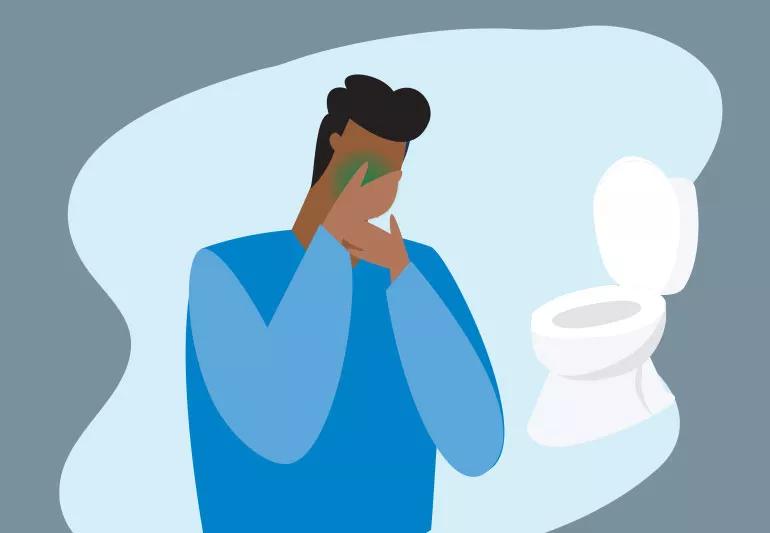Drink small amounts of water for a few hours after throwing up

It’s that feeling you wish you’d never had. You’re suddenly queasy. Your digestive system shifts violently into reverse. And that meal you just ate comes back to see the light of day.
Advertisement
Cleveland Clinic is a non-profit academic medical center. Advertising on our site helps support our mission. We do not endorse non-Cleveland Clinic products or services. Policy
Vomiting is definitely not fun. But it has a purpose.
“Vomiting is a reflex that allows the body to rid itself of ingested toxins and poisons,” says family medicine physician Matthew Goldman, MD.
After you vomit, it’s important to wait a few hours before eating or drinking like normal. Start by sipping small amounts of water and sucking on ice chips for about three to four hours. Then, you can consume clear liquids like water, diluted juices, ginger ale, clear broth and popsicles for another three to four hours.
Dr. Goldman shares some common causes of vomiting and how to recover.
Although it’s your belly in distress, “it is changes in your immune and/or nervous system that trigger the vomiting reflex,” explains Dr. Goldman.
Neurochemicals can travel different pathways to activate receptors that start the vomiting process.
A trigger zone in your brain may pick up immune changes or sense the presence of drugs or toxins. Or the medulla (part of your brainstem) may gather relevant information from different parts of your body. Or your vagus nerve, which runs from your brainstem to your GI tract, may signal that something is abnormal in your gut.
But the end result is always the same: Your last meal rockets up — and out.
Advertisement
Common causes of vomiting in adults include:
After throwing up, you’ll want to give your stomach time to recover. Here’s what to do.
Make hydration your main focus after a bout of vomiting, states Dr. Goldman.
Start by drinking small sips of water every 15 minutes for the first three to four hours. You can even suck on ice chips.
After that, you can drink clear fluids like water, diluted juices and ginger ale. And eat foods that are mostly liquid, like Jell-O®, clear broth and popsicles.
Ease yourself back into your regular diet with small amounts of bland foods like plain yogurt, plain oatmeal, grits, bread and crackers.
“Bland foods tend to be best because they require less digestion and, therefore, less demand and irritation on the lining of the stomach and intestines,” notes Dr. Goldman.
You’ll want to avoid fatty foods. They digest more slowly and can cause nausea. Steer clear of sugar and sugary or caffeinated drinks, which can cause dehydration.
“Some foods can irritate the lining of the stomach, as well as lead to an increased amount of urination, which can lead to dehydration,” says Dr. Goldman.
It’s also helpful to avoid strong smells, which may trigger your gag reflex.
“Strong odors may not agree with someone who is already feeling nauseous and this could trigger gagging, dry heaving and even vomiting,” says Dr. Goldman.
When you’re feeling well enough to eat, start off by consuming smaller meals, more frequently. And try to eat slowly.
“Similar to eating bland foods, less digestion equals less irritation and demand on the GI tract, which might already be inflamed or need rest while recovering,” says Dr. Goldman.
Many of us will try to prevent vomiting if we’re feeling nauseated. But if you’re feeling ill, it’s best to let yourself vomit naturally. But don’t force it, says Dr. Goldman.
Implementing a few good habits can help you steer clear of vomiting in many cases.
Your best defense against stomach viruses and bacteria is to wash your hands regularly. Use soap and warm water for at least 30 seconds. Scrub your fingernails, and in between your fingers as well.
To prevent food poisoning, keep tabs on expiration dates. Discard any unused food that’s past its prime.
Advertisement
If you get motion sickness or seasickness, take medication to stop nausea before it starts. If you feel a migraine coming on, take your headache medication at the earliest warning sign.
Finally, tell your doctor when pain is intolerable. They can help you find ways to minimize it. And if your medication is making you queasy, ask your doctor about alternative options.
Sometimes, an upset stomach is harmless. Having one episode of vomiting isn’t usually concerning, Dr. Goldman assures. You throw up and then immediately feel better.
But other times, vomiting requires medical attention.
“If you’re still vomiting after two days — especially if you have significant chest or belly pain — you should see your doctor,” he says.
If these symptoms accompany vomiting, seek medical attention:
“Vomiting can make people severely dehydrated, which can lead to serious complications,” cautions Dr. Goldman. “Our bodies depend on good circulation to carry oxygen and nutrients around. If there’s not enough fluid, circulation doesn’t happen. And that can be life-threatening.”
Advertisement
That doesn’t mean you should run to the doctor every time you vomit. But when vomiting is frequent or prolonged, you’ll need to know what’s causing it so you can feel better.
“If you can’t keep anything down, come in and get IV fluids and medication,” he says. “You might even need to have some imaging done to help pinpoint the problem.”
Advertisement
Learn more about our editorial process.
Advertisement

Throwing up is typically from a stomach bug, but it can also be a sign of other digestive issues

How to treat vomiting at home and when to see a doctor

Misleading claims, lack of scientific evidence and the risk of over-doing it are all concerns

Start slowly with clear fluids, and then move to bland, easy-to-digest foods

Help your aching belly by staying hydrated, eating bland foods and avoiding certain foods

Vomiting and fevers are a hard no — other symptoms are a judgment call

Hunger is the obvious cause, but food quality, and lack of protein and water are also key

Different symptoms call for different menus

Type 2 diabetes isn’t inevitable with these dietary changes

Applying a hot or cold compress can help with pain